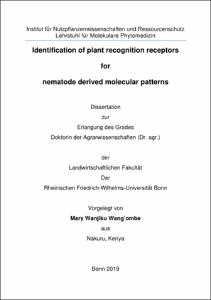Wang'ombe, Mary Wanjiku: Identification of plant recognition receptors for nematode derived molecular patterns. - Bonn, 2019. - Dissertation, Rheinische Friedrich-Wilhelms-Universität Bonn.
Online-Ausgabe in bonndoc: https://nbn-resolving.org/urn:nbn:de:hbz:5n-53429
Online-Ausgabe in bonndoc: https://nbn-resolving.org/urn:nbn:de:hbz:5n-53429
@phdthesis{handle:20.500.11811/7981,
urn: https://nbn-resolving.org/urn:nbn:de:hbz:5n-53429,
author = {{Mary Wanjiku Wang'ombe}},
title = {Identification of plant recognition receptors for nematode derived molecular patterns},
school = {Rheinische Friedrich-Wilhelms-Universität Bonn},
year = 2019,
month = jan,
note = {Plant parasitic nematodes are pathogens of great economic importance causing major losses in various food crops world-wide. A reliable, effective and efficient control method is establishing resistant cultivars of which understanding plant defense against nematodes is the first step towards this solution. Plant defence relies on recognition of Pathogen-Associated Molecular Patterns (PAMPs) by surface-localised Pattern-Recognition Receptors (PRRs) prior to pathogen penetration. Upon PAMP perception, PRRs trigger intracellular signalling cascades leading to activation of PAMP-Triggered Immunity (PTI). PRRs perceiving a wide-range of PAMPs have now been characterized for various models of plant-pathogen interactions; however, even though Nematode derived PAMPs (NAMPS) such as ascarosides have been identified, none of their perceiving receptors have been characterized. Here we show that invasion of Arabidopsis roots by parasitic nematodes triggers PTI-like responses including an upregulation of defense related genes. Treating Arabidopsis roots with a nematode aqueous solution (NemaWater) similarly induced expression of defense genes. Among the upregulated genes were a number of plasma-membrane – localized Receptor-Like Kinases (RLKs) belonging to Leucine Rich Repeat (LRRs), Never In Mitosis A (NIMA) rElated Kinases (NEKs), Cysteine-Rich RLKs (CRKs) and Phytosulfokine Kinase (PSK) families. Nematode infection assays with candidate genes demonstrated that loss of NILR1 (for NEMATODE-INDUCED LRR-RLK 1) expression enhances the susceptibility of plants to a broad range of nematodes suggesting that NILR1 is a PRR that perceives a conserved nematode-derived NAMP. This finding is equally supported by experiments showing that nilr1 is defective in ROS burst as well as in seedling growth inhibition upon NemaWater treatment compared with wild-type control. In addition, presence ROS burst by NemaWater on rice plants suggested triggering of PTI by a NILR1 homologue in rice.
We further showed AtNEK5 and NILR3 as potential NAMP receptors due to susceptibility of their knock out mutants to sedentary nematodes while two CRKs; CRK 19 and CRK10 portrayed roles in defense against nematodes in a species dependent manner. In addition, we demonstrated that the co-receptor BAK1 can be utilized to mine for potential receptors and signalling components involved in immunity against nematodes through successful BAK1-GFP pull down assay. The identification of NILR1 among others PRR perceiving NAMPs and successful baiting of BAK1 to pulldown nematode derived immunity components are major steps forward in understanding plant basal defense against nematodes. Consequently, these findings will not only increase knowledge into plant-nematode interaction but also pave way for further exploration of plant immunity studies. As a direct effect, the vital information from this study remains as a resource for molecular breeding of nematode resistant plants and a solution to yield loss due to nematode.},
url = {https://hdl.handle.net/20.500.11811/7981}
}
urn: https://nbn-resolving.org/urn:nbn:de:hbz:5n-53429,
author = {{Mary Wanjiku Wang'ombe}},
title = {Identification of plant recognition receptors for nematode derived molecular patterns},
school = {Rheinische Friedrich-Wilhelms-Universität Bonn},
year = 2019,
month = jan,
note = {Plant parasitic nematodes are pathogens of great economic importance causing major losses in various food crops world-wide. A reliable, effective and efficient control method is establishing resistant cultivars of which understanding plant defense against nematodes is the first step towards this solution. Plant defence relies on recognition of Pathogen-Associated Molecular Patterns (PAMPs) by surface-localised Pattern-Recognition Receptors (PRRs) prior to pathogen penetration. Upon PAMP perception, PRRs trigger intracellular signalling cascades leading to activation of PAMP-Triggered Immunity (PTI). PRRs perceiving a wide-range of PAMPs have now been characterized for various models of plant-pathogen interactions; however, even though Nematode derived PAMPs (NAMPS) such as ascarosides have been identified, none of their perceiving receptors have been characterized. Here we show that invasion of Arabidopsis roots by parasitic nematodes triggers PTI-like responses including an upregulation of defense related genes. Treating Arabidopsis roots with a nematode aqueous solution (NemaWater) similarly induced expression of defense genes. Among the upregulated genes were a number of plasma-membrane – localized Receptor-Like Kinases (RLKs) belonging to Leucine Rich Repeat (LRRs), Never In Mitosis A (NIMA) rElated Kinases (NEKs), Cysteine-Rich RLKs (CRKs) and Phytosulfokine Kinase (PSK) families. Nematode infection assays with candidate genes demonstrated that loss of NILR1 (for NEMATODE-INDUCED LRR-RLK 1) expression enhances the susceptibility of plants to a broad range of nematodes suggesting that NILR1 is a PRR that perceives a conserved nematode-derived NAMP. This finding is equally supported by experiments showing that nilr1 is defective in ROS burst as well as in seedling growth inhibition upon NemaWater treatment compared with wild-type control. In addition, presence ROS burst by NemaWater on rice plants suggested triggering of PTI by a NILR1 homologue in rice.
We further showed AtNEK5 and NILR3 as potential NAMP receptors due to susceptibility of their knock out mutants to sedentary nematodes while two CRKs; CRK 19 and CRK10 portrayed roles in defense against nematodes in a species dependent manner. In addition, we demonstrated that the co-receptor BAK1 can be utilized to mine for potential receptors and signalling components involved in immunity against nematodes through successful BAK1-GFP pull down assay. The identification of NILR1 among others PRR perceiving NAMPs and successful baiting of BAK1 to pulldown nematode derived immunity components are major steps forward in understanding plant basal defense against nematodes. Consequently, these findings will not only increase knowledge into plant-nematode interaction but also pave way for further exploration of plant immunity studies. As a direct effect, the vital information from this study remains as a resource for molecular breeding of nematode resistant plants and a solution to yield loss due to nematode.},
url = {https://hdl.handle.net/20.500.11811/7981}
}






